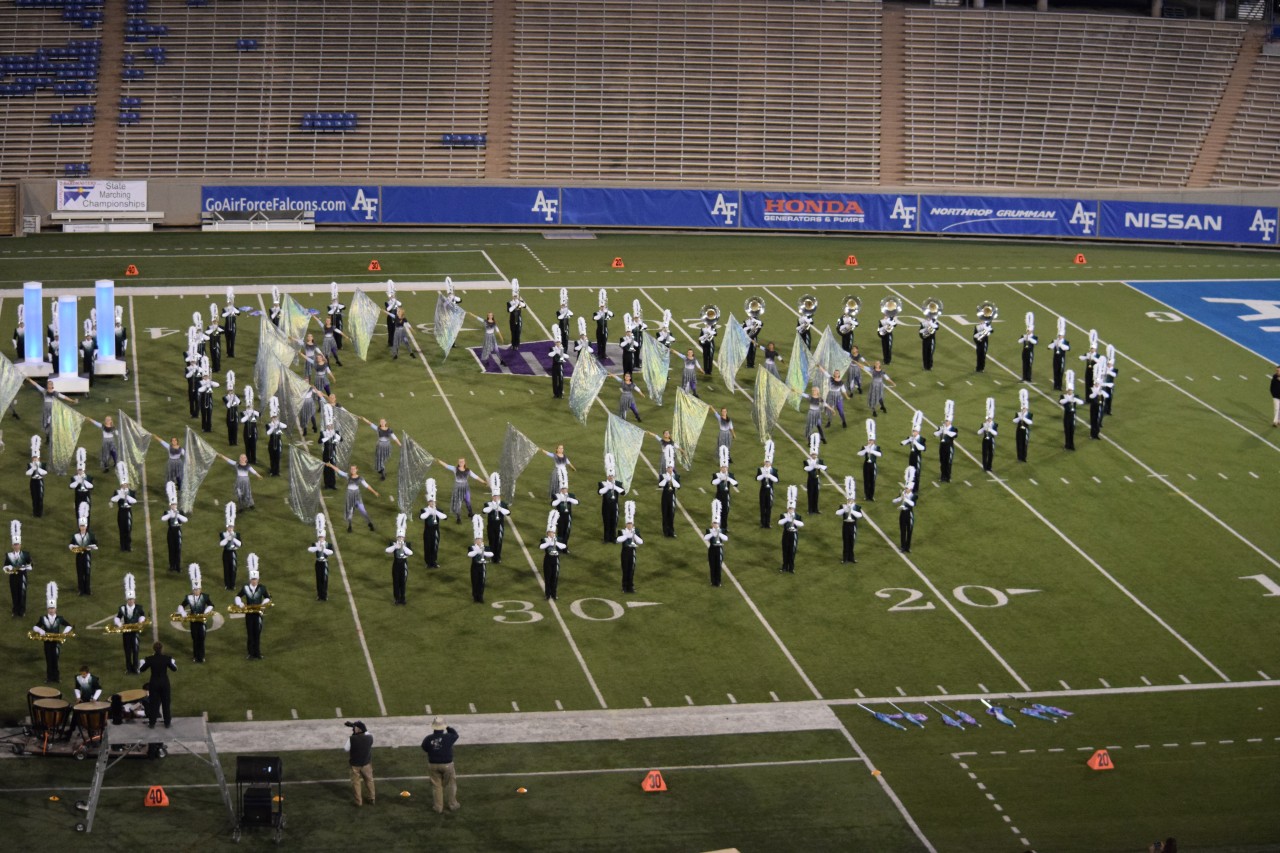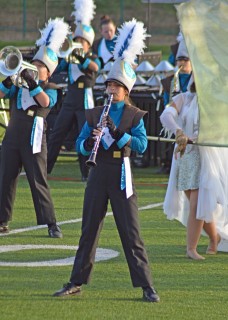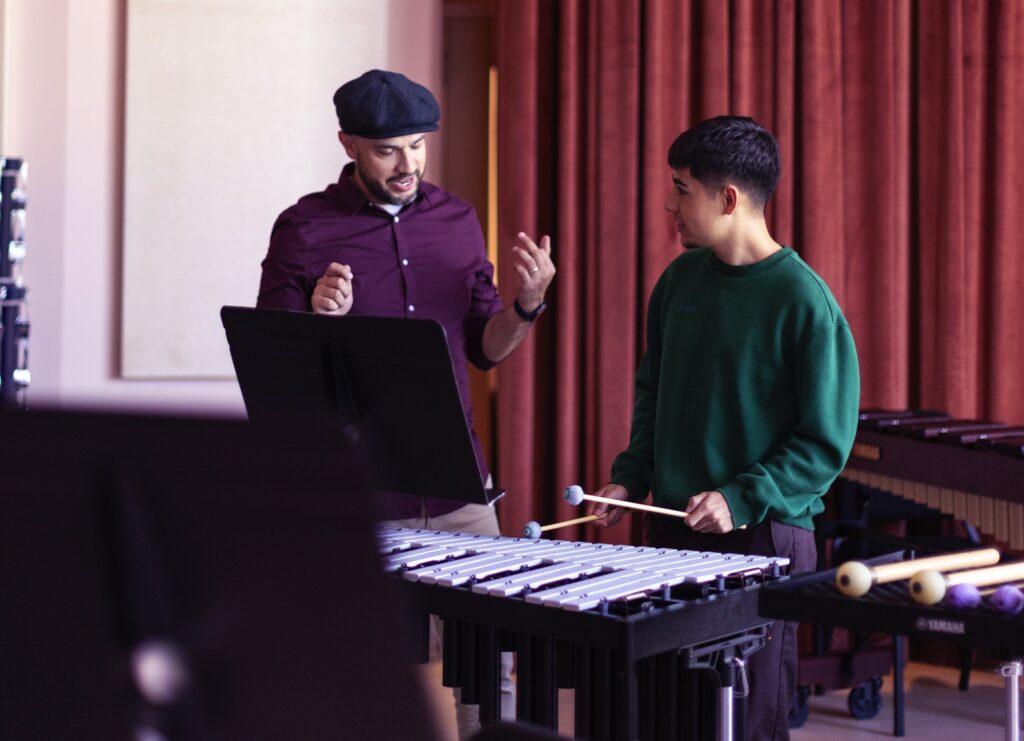Phase Out Phasing Problems
Get your marching band in sync using practical ideas to combat sound delays on the field.
Any elementary-level science class teaches students that sound and light travel at different speeds; in the context of marching band, this abstract concept becomes a real challenge.
Directors may be faced with a frustrating mystery when the ensemble seems to be doing everything perfectly in the band room, yet it sounds so off on the field. The problem simply boils down to that science lesson.
So how do students and conductors overcome the basic physics of time and space in order to produce a flawless, perfectly synchronized show across the whole field? Try these tips from leading marching instructors.
Listen or Watch?
The most important factor is to give students clear and precise instruction on when to listen and when to watch.
“That really is the major key — whether you watch or listen,” says Greg Bimm, who has been director of bands at Marian Catholic High School in Chicago Heights, Illinois, for 40 years. “In every circumstance, the acoustics are a little bit different. It depends on how the music is scored, where the pulse comes from; it depends on what people are playing immediately before.”
Setting a few broad guidelines based on the musicians’ positions on the field can be a good start.
“Generally, for us, a rule is if you are in front of the drum line, then it’s a listening zone,” says Daniel Berard, Yamaha Master Educator and director of bands at Fossil Ridge High School in Fort Collins, Colorado. “The farther forward you are on the field — for us it’s between the 40-yard lines and the front hash — that’s a listening zone. The farther back, we’ve designated as watching zones.”
Fossil Ridge has about 200 members and has been a consistent Colorado state marching band finalist and won the class 5A championship in 2012 and 2013.
Find the Pulse
Ask students to discover what the time feels like within the context of the music rather than relying on a downbeat.
“Developing as an ensemble all comes down to how well the ensemble develops its sense of pulse,” Berard says. “If the students aren’t always tied to a Dr. Beat [metronome] in rehearsals that does allow a little bit of independence for the students.”
For a smaller group, like the 50-student Archbishop Alter High School band in Kettering, Ohio, consider relying completely on the feel and sound. The Alter band, which has won the Mid-States Band Association A class championship every year since 2012, has done away with the visual role of a drum major entirely, instead allowing students to feel the beat of the music from set percussion points. “We use grounded percussion that we put on the field,” says Todd Tucker, director of bands. “That pulse from our percussion stays in one place. We always know this is where the pulse is and where the beat is coming from.”
Interpret Visual Downbeats
In those bands that do have conductors and drum majors, try different watching techniques for students in different sections. “We might tell somebody to play the downbeat when you see the ictus [or beat] is even with the conductor’s shoulder instead of their sternum,” Berard says. “It allows people who are farther back or farther out to account for that sound delay and play slightly ahead of what their peers who are close to the front or the center are playing.”
Another way is to tell students to watch the hands. “Anticipate exactly where the drum major’s hand is going to be, and you play at that instant,” Bimm says. “If we use the term ‘play on the front side of the hands’ to the end zone people and ‘play dead on the hands’ from the back 50, we never missed [the beat].”
Plan Ahead
Issues can also be handled before players even get on the field by keeping the spacing problem in mind while creating the drill. Look out for certain musical passages such as complex melodic tradeoffs between sections where phasing issues will stand out more. “Most of the time, it starts with really studying the musical score in conjunction with writing the drill,” Tucker says. “So we take it section by section with the score, and there’s a lot of preparation.”
However, don’t adjust the music or drill just to make things easier. Finding the right balance takes a deep knowledge of your band. “It really is an analysis,” Bimm says. “Knowing where the strong voices are going to come from and making sure I get them in the right place, so I can create as few of those problems as possible. But I try not to overcorrect. I try not to compromise the visual integrity, just so they can play together.”
Through Bimm’s leadership, the Marian Catholic band — currently with about 250 members — has been a finalist in Bands of America Grand Nationals competition every year since 1984.
Change Things Up
If something isn’t working, don’t be afraid to change the setup. “You have to be aware if something doesn’t get staged quite appropriately,” Berard says. “Have the freedom to re-orchestrate things, so that maybe the people who are more focused and featured in the drill can be more featured and focused in the music … even if it’s not quite what the original voicing might have intended.”
These changes might even mean adding aids such as microphones and speakers directly into the drill setup. “We write our music with speaker placement in mind,” Tucker says. “We do things like panning the melodies in the speakers from side to side … to ensure that the kids can hear each other and reinforce what they need to hear in certain areas of the field.”
Don’t Lose Hope
If you’re still having trouble with phasing issues, know that you’re not alone. Don’t be afraid to look for outside help. “There are some great YouTube resources from people who have really taken this to the extreme and demonstrated how this time delay really manifests itself,” Berard says.
A quick search of “marching band sound delay” will give you a plethora of great ideas.
No matter how long it takes, solving these problems is not impossible. “Be patient,” Bimm says. “Keep working at it because you will find a solution. Sometimes it’s just a keyword you say, and it strikes a chord with the kids.”
Photos © 2017 Marian Catholic High School Band, Courtesy of Matt Black and Ken Muszinski; Fossil Ridge High School Band, Submitted by Band Parents; Archbishop Alter High School Band by Tim McHenry
This article originally appeared in the 2017 V2 issue of Yamaha SupportED. To see more back issues, find out about Yamaha resources for music educators, or sign up to be notified when the next issue is available, click here.


















